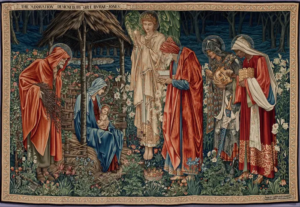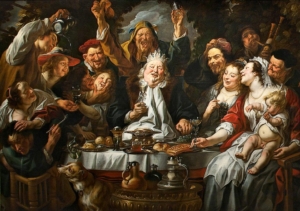The traditions of 12th Night
TWELFTH NIGHT

“The Adoration of the Magi” by Edward Burne-Jones (1904)
Google Art Project
Christmastide is the Christian festival which begins on the eve of 24th December and continues for twelve days ending on the eve of January 5th. The following day, January 5th, is the date of one of the oldest festivals of the Christian church Epiphany. In ancient times a new day began at sunset, not in the middle of the night as it does today, thus the evening of what we call Christmas Eve, was the first day of the Christmas festival and the evening of 5th January was Twelfth Night, which then became Epiphany on the 6th. In 567 the Council of Tours decreed that the entire period between Christmas and Epiphany be celebrated as Christmastide.
Epiphany is the church festival that marks the showing of the infant Jesus to the Magi. It also celebrates the baptism of Jesus in the River Jordan by John the Baptist. Some Christian traditions celebrate Epiphany as a single day, others as a season stretching through Candlemas (2nd February) to Ash Wednesday. Special hymns are sung in church services and in some places models of the Three Kings are then added to the Nativity. The liturgical colours for Epiphany are white and gold. In the Orthodox faiths it is the custom to give gifts on 6th January rather than Christmas DayTwelfth Night is a much more secular event and it is associated with partying on a grand scale and many of its customs have links with pagan beliefs, as of course does Christmas. The Roman festival of Saturnalia fell in midwinter, which was a time of darkness and gloom when evil spirits and the dead roamed the land. To combat this, houses were decorated with greenery such as holly and mistletoe which were believed to ward off evil and a Yule log, brought into the house at Christmas, was kept burning. A superstition or belief, call it what you will, is that Christmas decorations must be taken down on Twelfth Night or misfortune will follow. The reason is that once Epiphany dawns the power of the greenery and the Yule log dies. The greenery is returned to the fields to protect the crops and the charred remains of the Yule log are kept to protect the home from thunder and lightning and to rekindle next Christmas’s log.

Pagan festivals were all about feasting and Twelfth Night was no exception. It was the culmination of twelve days of good food and drink. A special Twelfth Night cake was baked containing a bean and sometimes a pea. Whoever ate the slice with the bean became the Lord or King of Misrule who would supervise the festivities. The pea was intended for a lady to become Queen but how they ensured that the correct slices were eaten by the correct sex I’m not sure. Riotous games, tricks played on the unsuspecting and general merrymaking and rowdiness were the order of the day and the tradition of Wassailing on Twelfth Night developed in the apple growing areas of the West country. Wassail comes from the Anglo Saxon ‘waes hal’ and means ‘be whole’. If greeted with ‘wassail’ the reply was ‘drinkhail’ meaning ‘your health’ and it is a toast regularly used today. The wassail cup was filled with punch or mulled cider, taken from house to house and shared; bonfires were lit in the apple orchards and there was much singing and dancing. There are several old songs about wassailing.
Old pagan beliefs surface in the shape of the fertility symbol, the Green Man, who appears on Twelfth Night as the Holly Man. On Twelfth Night in celebrations on the River Thames by Shakespeare’s Globe Theatre, he comes with the Bankside Mummers (strolling players) bringing in the green and wassailing the people with the Town Crier of London in order to encourage growth. This is then usually followed by the St George play about the saint and the dragon. William Shakespeare’s play The Twelfth Night was believed written in 1601/1602 as a Twelfth Night entertainment and the first recorded performance was at Candlemas in 1623.
Partying cannot go on for ever so after the festivities of Twelfth Night and the services of Epiphany life returned to normal. The eating and drinking and playing of riotous games was over; the Lord of Misrule was dethroned for another year, the wassail cup put away and it was back to work on Plough Monday